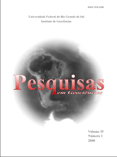The Holocene paleoenvironment in the Serra Velha region, RS, Brazil through a study of plant succession
DOI:
https://doi.org/10.22456/1807-9806.20299Palavras-chave:
Palynology, Paleoenrironment, Southern Brazil, Holocene.Resumo
Palynological studies in the marsh forest of Serra Velha (29º36’S – 51º38’W), Rio Grande do Sul, Brazil, detected a plant succession through hydrosere from a water body already somewhat filled up by herbaceous vegetation at 9800 ± 90 yr BP. The climatic amelioration at the beginning of the Holocene accentuated the filling up process. Later, between 7800 – 7280 ± 60 yr BP, a short phase of significant influence of the forest over the marsh occurred. A new significant expansion of the forest, beginning at about 6000 yr BP took place. This gave rise to the present forest which is represented by many species of the Atlantic rain forest. Compared to the already existing palynological data about the Coastal Plain, it becomes evident that the present Serra Velha forest is older, which seems to indicate the importance of the foothill forests of Serra Geral in forming the present coastal vegetation in Rio Grande do Sul.



